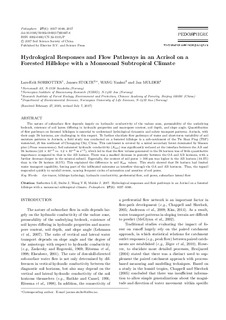| dc.contributor.author | Sørbotten, Lars-Erik | |
| dc.contributor.author | Stolte, Jannes | |
| dc.contributor.author | Wang, Yanhui | |
| dc.contributor.author | Mulder, Jan | |
| dc.coverage.spatial | China | nb_NO |
| dc.date.accessioned | 2018-09-27T11:36:26Z | |
| dc.date.available | 2018-09-27T11:36:26Z | |
| dc.date.created | 2017-11-28T08:26:19Z | |
| dc.date.issued | 2017 | |
| dc.identifier.citation | Pedosphere. 2017, 27 (6), 1037-1048. | nb_NO |
| dc.identifier.issn | 1002-0160 | |
| dc.identifier.uri | http://hdl.handle.net/11250/2564987 | |
| dc.description.abstract | The nature of subsurface flow depends largely on hydraulic conductivity of the vadoze zone, the permeability of the underlying bedrock, the existence of soil layers differing in hydraulic properties and macropore content, soil depth and slope angle. Quantification of flow pathways on forested hillslopes is essential to understand the hydrological dynamics and solute transport patterns. Acrisols, with their argic Bt horizons, are challenging in this respect. To increase the understanding of flow pathways of water and the short-term variability of the soil moisture patterns in Acrisols, a field study was conducted on a forested hillslope in the Tie Shan Ping (TSP) watershed, 25 km northeast of Chongqing city, PR China. This catchment is covered by mixed secondary forest dominated by Masson pine (Pinus Massoniana). The soil's Ksat reduced significantly at the interface between the AB and Bt horizons (2.6E-05 versus 1.2E-06 m s−1). This led to that the flow volume generated in the Bt horizon was of little quantitative importance compared to that in the AB horizon. There was a marked decrease in porosity between the O/A horizon and the AB horizon, with a further decrease deeper in the mineral subsoil. Especially the content of pores >300 µm were higher in the AB horizon (14.3%) compared to the Bt horizon (6.5%). This explains the difference in Ksat values. Our study shows that Bt horizons have limited water transport capability, forcing part of the infiltrated rainwater as interflow through the OA and AB horizons. The topsoil thus responds quickly to rainfall events, causing frequent cycles of saturation and aeration of soil pores | nb_NO |
| dc.description.abstract | Hydrological Responses and Flow Pathways in an Acrisol on a Forested Hillslope with a Monsoonal Subtropical Climate | nb_NO |
| dc.language.iso | eng | nb_NO |
| dc.subject | Flow pathways | nb_NO |
| dc.subject | Hydrological responses | nb_NO |
| dc.title | Hydrological Responses and Flow Pathways in an Acrisol on a Forested Hillslope with a Monsoonal Subtropical Climate | nb_NO |
| dc.title.alternative | Hydrological Responses and Flow Pathways in an Acrisol on a Forested Hillslope with a Monsoonal Subtropical Climate | nb_NO |
| dc.type | Journal article | nb_NO |
| dc.type | Peer reviewed | nb_NO |
| dc.description.version | acceptedVersion | nb_NO |
| dc.rights.holder | C 2017 Soil Science Society of China | nb_NO |
| dc.subject.nsi | VDP::Landbruks- og Fiskerifag: 900::Landbruksfag: 910 | nb_NO |
| dc.source.pagenumber | 1037-1048 | nb_NO |
| dc.source.volume | 27 | nb_NO |
| dc.source.journal | Pedosphere | nb_NO |
| dc.source.issue | 6 | nb_NO |
| dc.identifier.doi | 10.1016/S1002-0160(17)60447-8 | |
| dc.identifier.cristin | 1519264 | |
| dc.relation.project | Norges forskningsråd: 193725 | nb_NO |
| dc.relation.project | Norges forskningsråd: 209696 | nb_NO |
| cristin.ispublished | true | |
| cristin.fulltext | postprint | |
| cristin.qualitycode | 1 | |
